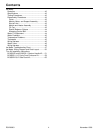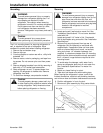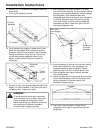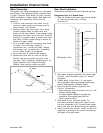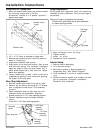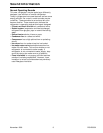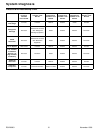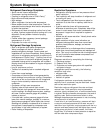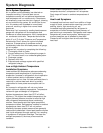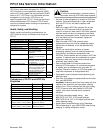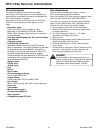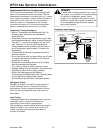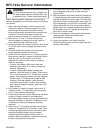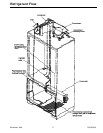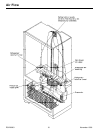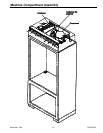
RS1200001 12 November 1996
System Diagnosis
Air in System Symptoms
Air in system can be caused by low side leak or
improper servicing. If low side leak occurs,
temperature control will not achieve temperatures
and compressor will run continuously. Compressor
will eventually pump low side into a vacuum, drawing
air and moisture into system. Air and R134a do not
mix. Air pressure will be added to normal head
pressure, resulting in higher than normal head
pressures.
Determine if air is present by reading head pressure
gauge with refrigerator off and evaporator and
condenser at same temperature. Verify temperature
on condenser outlet tube. Temperature should be
within 3° or 4°F of what "Pressure and Temperature
Relationship Chart" shows for a given idle head
pressure. If temperature of condenser outlet is
considerably lower than idle head pressure of gauge,
air is in system.
Diagnose air in system by completing the following:
1. Thoroughly check for leaks.
2. Correct leak source. Do not attempt to purge air
off. This could result in an undercharged system.
3. Discharge system.
4. Replace drier-filter.
5. Evacuate and recharge system with specified
refrigerant charge.
Low or High Ambient Temperature
Installation Symptoms
Lower ambient air temperature reduces condensing
temperature and temperature of liquid entering
evaporator. Increase in refrigeration due to operation
in lower ambient results in decrease in power
consumption and run time. At lower ambients there is
reduction in cabinet heat leak which is partially
responsible for lower power consumption and run
time.
An increase in refrigeration will not occur below
certain minimum ambient temperature. Temperature
varies with type and design of refrigerator.
Ambient temperatures lower than 55°F will affect
efficiency. The higher the ambient temperature, the
higher the head pressure must be to raise the high
side refrigerant temperature above condensing
medium. Head pressure will be higher as ambient
temperature raises. Refrigerators installed in ambient
temperatures lower than 55°F will not perform
effeciently because system pressures are generally
reduced and unbalanced. Lower head pressure forces
less liquid refrigerant through capillary line, resulting
in symptoms of refrigerant shortage. The lower the
ambient temperature, the more pronounced the
condition.
When ambient temperature is below cut-in of
temperature control, compressor will not operate.
Drain traps will freeze in ambient temperatures of
32°F.
Heat Load Symptoms
Increased heat load can result from addition of large
supply of foods, excessive door openings, poor door
sealing, interior light remaining on, etc.
Increased heat being absorbed by refrigerant in
evaporator will affect temperature and pressure of
gas returning to compressor. Refrigerator and freezer
temperatures, power consumption, discharge, and
suction pressures are all affected by heat load.
Pressures will be higher than normal under heavy
heat load.



